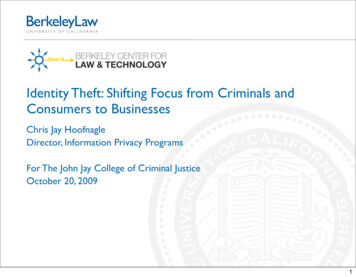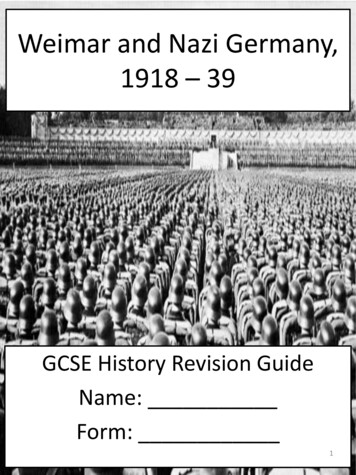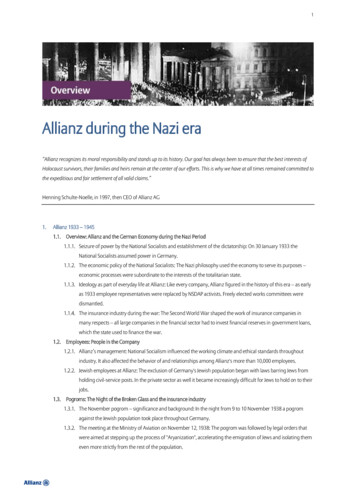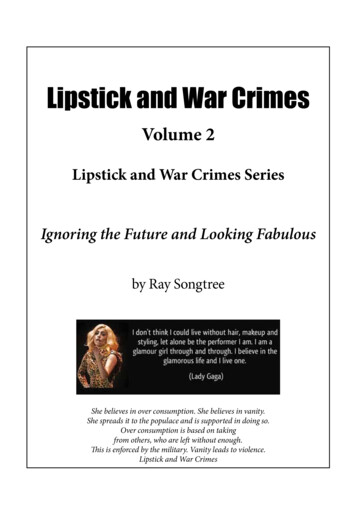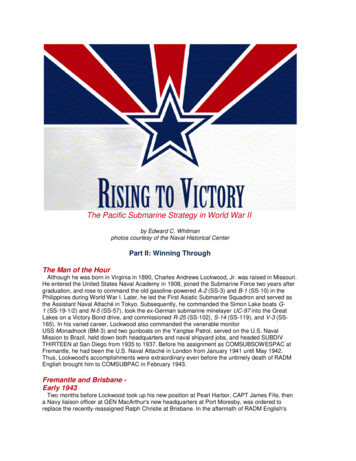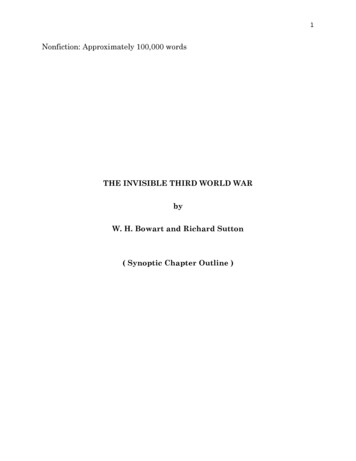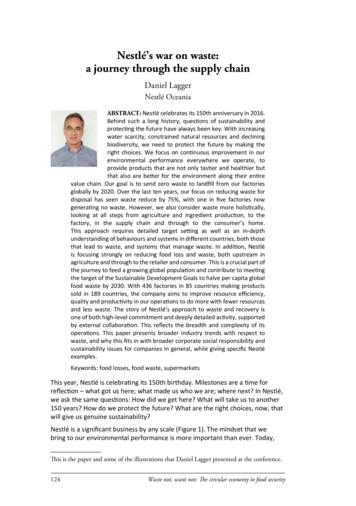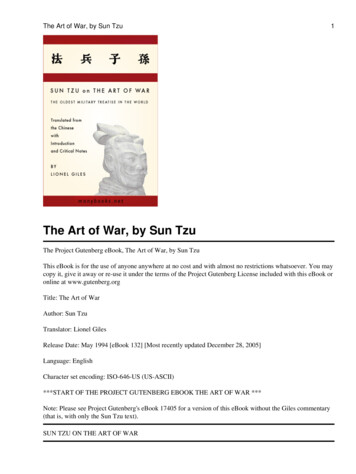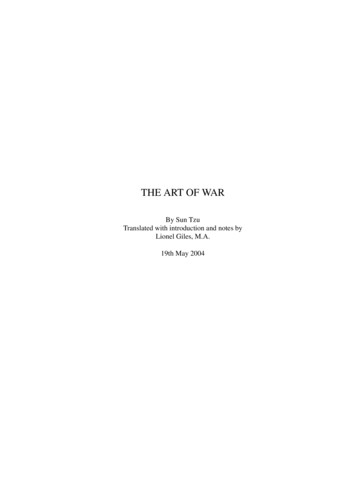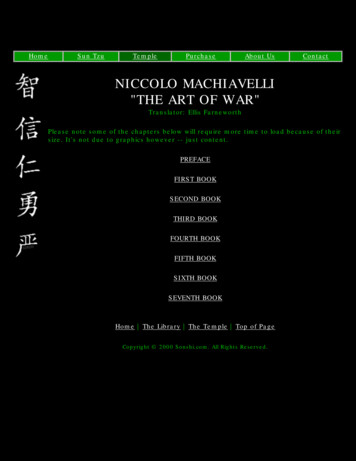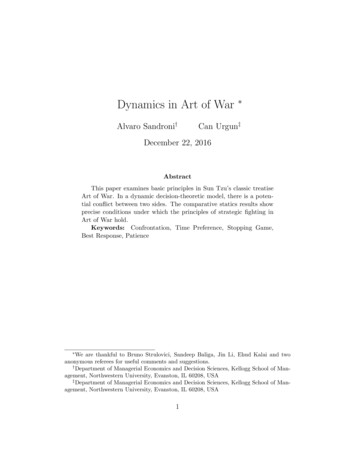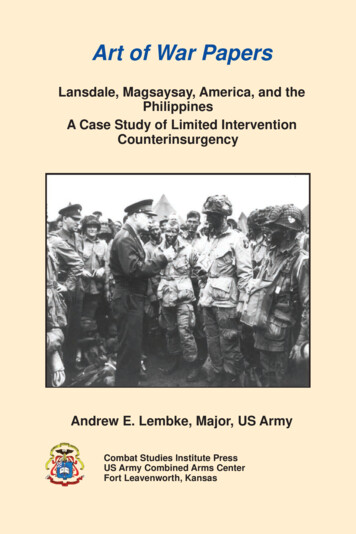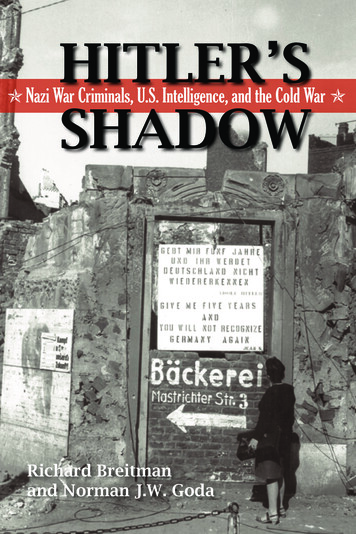
Transcription
HITLER’SSHADOWO Nazi War Criminals, U.S. Intelligence, and the Cold War ORichard Breitmanand Norman J.W. Goda
HITLER’SSHADOW
HITLER’SSHADOWNazi War Criminals, U.S.Intelligence, and the Cold WarRichard Breitman and Norman J.W. GodaPublished by the National Archives
Cover: U.S. Army sign erected by destroyed remains in Berlin.RG 111, Records of Office of the Chief Signal Officer.
CONTENTSPreface viIntroduction 1CHAPTER ONE New Information on Major Nazi Figures5CHAPTER TWO Nazis and the Middle East17CHAPTER THREE New Materials on Former Gestapo Officers35CHAPTER FOUR The CIC and Right-Wing Shadow Politics53CHAPTER FIVE Collaborators: Allied Intelligence and theOrganization of Ukrainian Nationalists73Conclusion 99Acronyms 101
PR EFAC EIn 1998 Congress passed the Nazi War Crimes Disclosure Act [P.L. 105-246]as part of a series of efforts to identify, declassify, and release federal records onthe perpetration of Nazi war crimes and on Allied efforts to locate and punishwar criminals. Under the direction of the National Archives the InteragencyWorking Group [IWG] opened to research over 8 million of pages of records including recent 21st century documentation. Of particular importance to thisvolume are many declassified intelligence records from the Central IntelligenceAgency and the Army Intelligence Command, which were not fully processedand available at the time that the IWG issued its Final Report in 2007.As a consequence, Congress [in HR 110-920] charged the National Archivesin 2009 to prepare an additional historical volume as a companion piece toits 2005 volume U. S. Intelligence and the Nazis. Professors Richard Breitmanand Norman J. W. Goda note in Hitler’s Shadow that these CIA & Army recordsproduced new “evidence of war crimes and about wartime activities of warcriminals; postwar documents on the search for war criminals; documents aboutthe escape of war criminals; documents about the Allied protection or use of warcriminals; and documents about the postwar activities of war criminals”.This volume of essays points to the significant impact that flowed fromCongress and the Executive Branch agencies in adopting a broader and fullerrelease of previously security classified war crimes documentation. Details aboutrecords processed by the IWG and released by the National Archives are morefully described on our website iwg@nara.gov.William Cunliffe, Office of Records Services,National Archives and Records Administration
INTR ODUCTIONAt the end of World War II, Allied armies recovered a large portion of thewritten or filmed evidence of the Holocaust and other forms of Nazi persecution.Allied prosecutors used newly found records in numerous war crimes trials.Governments released many related documents regarding war criminals duringthe second half of the 20th century. A small segment of American-held documentsfrom Nazi Germany or about Nazi officials and Nazi collaborators, however,remained classified into the 21st century because of government restrictions onthe release of intelligence-related records.Approximately 8 million pages of documents declassified in the UnitedStates under the 1998 Nazi War Crimes Disclosure Act added significantly toour knowledge of wartime Nazi crimes and the postwar fate of suspected warcriminals. A 2004 U.S. Government report by a team of independent historiansworking with the government’s Nazi War Criminal Records Interagency WorkingGroup (IWG), entitled U.S. Intelligence and the Nazis, highlighted some of thenew information; it appeared with revisions as a 2005 book.1 Our 2010 reportserves as an addendum to U.S. Intelligence and the Nazis; it draws upon additionaldocuments declassified since then.The latest CIA and Army files have: evidence of war crimes and about thewartime activities of war criminals; postwar documents on the search for orprosecution of war criminals; documents about the escape of war criminals;documents about the Allied protection or use of Nazi war criminals; anddocuments about the postwar political activities of war criminals. None of the1
declassified documents conveys a complete story in itself; to make sense of thisevidence, we have also drawn on older documents and published works.The Timing of DeclassificationWhy did the most recent declassifications take so long? In 2005–07 theCentral Intelligence Agency adopted a more liberal interpretation of the 1998Nazi War Crimes Disclosure Act. As a result, CIA declassified and turned overto the National Archives and Records Administration (NARA) additionaldocuments from pre-existing files as well as entirely new CIA files, totaling morethan 1,100 files in all. Taken together, there were several thousand pages of newCIA records that no one outside the CIA had seen previously.A much larger collection came from the Army. In the early postwar years,the Army had the largest U.S. intelligence and counterintelligence organizationsin Europe; it also led the search for Nazi war criminals. In 1946 Army intelligence(G-2) and the Army Counterintelligence Corps (CIC) had little competition—the CIA was not established until a year later. Even afterwards, the Army remaineda critical factor in intelligence work in central Europe.Years ago the Army facility at Fort Meade, Maryland, turned over to NARAits classified Intelligence and Security Command Records for Europe from theperiod (approximately) 1945–63. Mostly counterintelligence records from theArmy’s Investigative Records Repository (IRR), this collection promised to bea rich source of information about whether the United States maintained aninterest in war crimes and Nazi war criminals.After preserving these records on microfilm, and then on a now obsoletesystem of optical disks, the Army destroyed many of the paper documents. Butthe microfilm deteriorated, and NARA could not read or recover about half ofthe files on the optical disks, let alone declassify and make them available. NARAneeded additional resources and technology to solve the technological problemsand transfer the IRR files to a special computer server. Declassification of theseIRR files only began in 2009, after the IWG had gone out of existence.This new Army IRR collection comprises 1.3 million files and many millionsof pages. It will be years before all of these Army files are available for researchers.2 Introduction
For this report we have drawn selectively upon hundreds of these IRR files,amounting to many thousands of pages, which have been declassified and arealready available at NARA.Intelligence Organizations and War CrimesAmerican intelligence and counterintelligence organizations each had its ownraison d’être, its own institutional interests, and its own priorities. Unfortunately,intelligence officials generally did not record their general policies and attitudestoward war crimes and war criminals, so that we hunted for evidence in theirhandling of individual cases. Despite variations, these specific cases do showa pattern: the issue of capturing and punishing war criminals became lessimportant over time. During the last months of the war and shortly after it,capturing enemies, collecting evidence about them, and punishing themseemed quite consistent. Undoubtedly, the onset of the Cold War gave Americanintelligence organizations new functions, new priorities, and new foes. Settlingscores with Germans or German collaborators seemed less pressing; in somecases, it even appeared counterproductive.In the months after the war in Europe ended Allied forces struggled tocomprehend the welter of Nazi organizations. Allied intelligence agencies initiallyscrutinized their German intelligence counterparts for signs of participationin underground organizations, resistance, or sabotage. Assessing threats to theAllied occupation of Germany, they thought first of Nazi fanatics and Germanintelligence officials. Nazi officials in the concentration camps had obviouslycommitted terrible crimes, but the evidence about the Gestapo was not as striking.The Allies started by trying to find out who had been responsible for what.NOTES1 Richard Breitman, Norman J.W. Goda, Timothy Naftali, and Robert Wolfe, U.S. Intelligence and theNazis (New York: Cambridge University Press, 2005).Introduction 3
Gertrude (Traudl) Junge, one of Hitler’s personal secretaries, stayed in the Reichschancellery bunker totake Hitler’s last will and testament before his suicide. Junge describes the perils in working her waythrough the Russian lines surrounding Berlin. She relates meeting Hitler’s chauffeur Kemka and of thedeaths of Martin Bormann, Stumpfegger, and Naumann, when their armored car was blown up.RG 319, Records of the Army Staff.
CHAPTER ONENew Information on Major Nazi FiguresNewly released Army records yield bits of intriguing information collected bythe Army Counterintelligence Corps (CIC) after the war about some leadingofficials of the Nazi regime. The new information tends to confirm rather thanchange what historians have known about leading Nazi functionaries and theirpostwar fates. At the same time, it provides sharper focus than before.New Interrogations of Hitler’s Personal SecretaryGertraud (Traudl) Junge, Adolf Hitler’s secretary starting in January 1943, tookthe dictation for Hitler’s final testaments on April 29, 1945, the night beforeHitler committed suicide. On May 2, 1945, she fled Hitler’s bunker in Berlin witha small group, trying to move through Soviet lines to safety. The Soviets capturedher on June 3. They imprisoned and interrogated her in their sector of Berlin.She left Berlin and went to Munich in April 1946.Junge’s recollections are an important source for Hitler’s final days in thebunker. Soviet intelligence took great pains to confirm Hitler’s death amidstpersistent rumors that he was still alive, as did Allied investigators.1 (Sovietinterrogations of Junge have not yet surfaced.) On her return to Munich shegave many statements, most of which are well known to scholars. They includea series of interviews in Munich by U.S. Judge Michael Musmanno in Februaryand March 1948 when Musmanno was investigating the circumstances of Hitler’s5
death.2 She also wrote a personal memoir in 1947, made available to scholarsin Munich’s Institute for Contemporary History and published in 2002.3 Shegave testimony to German authorities in 1954 as well as numerous interviewsto journalists in the years after the war, most famously in a 2002 Germandocumentary film titled Im toten Winkel (Blind Spot). She died the same yearat age 81.On June 9, 1946, the CIC Field Office in Starnberg arrested Junge in Munich,and CIC agents interrogated her on June 13 and June 18. On August 30, CICagents interviewed her a third time at the request of British intelligence, this timewith 15 specific British questions. These summer 1946 interrogations are notcited in scholarly works on Hitler’s final days. Possibly released here for the firsttime, they contain occasional detail and nuance that the other statements do not,because they were Junge’s first statements on returning to the West.In the first session Junge recalled Hitler’s personal habits, confirming,albeit in new language, what is well known. She recounted Hitler’s withdrawnbehavior after the German military defeat at Stalingrad in early 1943, hisinsistence that Germany’s miracle weapons would end the Allied bombingof German cities, and his belief that Providence protected him from the July20, 1944, assassination attempt. Junge remembered Hitler saying that if Clausvon Stauffenberg, the leader of the conspiracy, would have shot Hitler face toface instead of using a bomb, then von Stauffenberg would at least be worthyof respect. This interrogation also confirmed the death of Nazi Party SecretaryMartin Bormann by Soviet shelling in Berlin. Hitler’s chauffeur Erich Kempkawitnessed Bormann’s death and told Junge about it shortly afterwards. In July1946 Kempka gave the same story to the International Military Tribunal.4 At thetime many people thought that Bormann escaped and fled to South America.His remains were not discovered until 1999.5The second interrogation provides new detail on Junge’s attempted escapefrom Berlin after Hitler’s death, her arrest by the Soviets on June 3, 1945, and herrepeated interrogations by the Soviets concerning Hitler’s suicide. The Soviets werealso interested in any connections Junge might have to existing Nazi networks;they hoped to use her to uncover them. In September 1945, an unnamed Sovietofficial offered Junge his personal protection including an apartment, food, andmoney. In return, Junge was to cooperate with Soviet forces and not to tell anyone6 New Information on Major Nazi Figures
of her former or present job. She was not to leave the Soviet sector; but after shecontracted diphtheria, she was allowed admission to the hospital in the Britishsector. On leaving the hospital, she said, “the Russians did not take any moreinterest in my person.” She left for Munich and arrived on April 20, 1946.6Her third interrogation benefited from the direct questions from the British.Junge noted that Hitler hoped to delay his suicide until receiving confirmationthat the couriers carrying copies of his last political testament had reached theirrecipients, namely Grand Admiral Karl Dönitz, whom Hitler appointed headof state, and Field Marshal Ferdinand Schörner, whom he appointed armycommander-in-chief. With the ring closing around his Berlin bunker, Hitlerwould not allow the Soviets to take him alive. But he knew Dönitz, whoseheadquarters was near the Danish border, and Schörner, whose headquarterswas in Czechoslovakia, would fight until the last cartridge and hang as manydeserters as need be. “Hitler was uneasy,” recalled Junge, “and walked from oneroom to another. He said that he would wait until the couriers had arrived totheir destinations with the testaments and then he would commit suicide.”7 Thecouriers were not able to leave the Berlin area.The British were also very interested in Hitler’s Gestapo chief, Heinrich Müller,who would have offered a treasure trove of counterintelligence information onthe Soviets. Allied counterintelligence officers failed to locate him after the war.Some leads placed him in Berlin at war’s end and others suggested that he hadfled south. The absence of an arrest or even a corpse led to later conspiracytheories that Müller worked for either Allied or Soviet intelligence. The bulk ofthe evidence, pieced together over the next quarter century, indicates that Müllerwas killed in Berlin during the war’s final days.8Junge was asked directly: “On what occasions did you see Mueller in theBunker? What do you know of his movements or activities during the last days?”Junge did not know Müller personally. She noted that she saw him for the firsttime on April 22, 1945. “Mueller remained in the shelter until Hitler’s death,” shesaid. “I observed him talking some times (sic) with Hitler .” Junge continued,“I do not know any details about his activities. He had taken over the functionsof [Reich Security Main Office Chief Ernst] Kaltenbrunner .”9At the time of Hitler’s suicide, Kaltenbrunner was in Salzburg. He hadsearched for a negotiated peace through various channels while also hoping thatNew Information on Major Nazi Figures 7
an Alpine front could keep Germany from defeat.10 What Hitler knew of theseefforts in late April 1945 is not clear. But in his political testament he expelledHeinrich Himmler from the Nazi Party owing to Himmler’s contacts with theAllies. Hitler promoted Karl Hanke, the fanatical Gauleiter of Lower Silesia whodefended Breslau at the cost of some 40,000 civilian lives, to Himmler’s office ofReichsführer-SS. Kaltenbrunner was logically the next in line for Himmler’s job.Junge’s statement suggests that Hitler lost trust in Kaltenbrunner, that Müllerremained loyal to the end, and that Hitler trusted in his loyalty.New Documents: Arthur Greiser’s BriefcasesArthur Greiser, Nazi Gauleiter of the German-annexed portion of western Polandcalled the Warthegau, was a major war criminal by any standard or definition.Once conquered by the Germans in 1939, the Warthegau region was to be emptiedof Jews and Poles and settled with ethnic Germans. The Warthegau also includedthe Lodz ghetto—the second largest in occupied Poland—and the exterminationfacility at Chelmno where Jews were first gassed to death. Thus, Greiser helped toimplement Nazi policies that killed tens of thousands of expellees as well as morethan 150,000 mostly Jews in Chelmo itself.11 The U.S. Army captured Greiser inSalzburg on May 17, 1945, and extradited him to Poland. Using documents andwitness testimony, a Supreme National Tribunal in Warsaw tried and convictedhim in June and July 1946. He was hanged in mid-July.12When Greiser fled west in 1945, he carried with him two briefcases filledwith documents, mostly dealing with his activities during the 1930s and hispersonal affairs. Either he left behind or destroyed documents that connectedhim with policies of mass murder in the Warthegau, or what he kept of thosedocuments went to Polish authorities. Still, the U.S. Army retained more than2,000 pages of Greiser’s documents in the Investigative Records Repository thatonly now are declassified.13Some of the most interesting documents involve Greiser’s activities, fromNovember 1934 and afterwards, as president of the Senate of the internationalfree city of Danzig. This post made Greiser chief executive of a Germandominated municipal government frequently in conflict with the Polish state8 New Information on Major Nazi Figures
that surrounded it. How far to push these conflicts provoked discussion anddebate among the highest Nazi authorities in Berlin.Greiser wrote memoranda of his discussions with Hitler, HermannGöring, Foreign Minister Konstantin von Neurath, his successor Joachim vonRibbentrop, and others. The documents show conflicting views in Berlin abouthow best to deal with the Poles and the League of Nations. Hitler and the NaziParty Gauleiter of Danzig, Albert Forster, often wanted confrontation; Göringand Greiser, a more moderate course. Political disagreements help to explain thebitter personal rivalry between Greiser and Forster. Greiser’s documents do notchallenge the reigning historical consensus about these matters, but they do fillin the narrative. They also underscore––as historians have long argued––thatDanzig’s foreign policy was made in Berlin.14In 1939 Hitler used conflicts over Danzig as the pretext for Germanyto invade Poland. After the war, the Allies decided to charge high Naziauthorities with crimes against peace; the International Military Tribunalat Nuremberg made crimes against peace the central count of four chargesagainst high Nazi officials and organizations; the others were war crimes,crimes against humanity, and conspiracy. The Greiser file contains newevidence about the background to German aggression against Poland andthus about war crimes.The Search for Adolf Eichmann: New MaterialsToday, the world knows a great deal about Adolf Eichmann’s escape from Europeafter the war. While he was living in Argentina under the name of Ricardo Klement,Eichmann worked with the Dutch writer Willem Sassen to prepare a memoir ofsorts. In it Eichmann talks extensively about his escape from Germany. AfterIsraeli agents brought Eichmann to Israel in 1960, the authorities interrogatedhim rigorously. Historians have used these plentiful sources as well as earlierIWG declassifications.15 The most recent American declassifications fill in somesmall gaps. They show what the West knew about Eichmann’s criminality and hispostwar movements. No American intelligence agency aided Eichmann’s escapeor simply allowed him to hide safely in Argentina.New Information on Major Nazi Figures 9
In 1944, six months before the end of the war, Eichmann reported to Himmler on the exact number ofJews killed so far as 6,000,00––4,000,000 in the death camps and an additional 2,000,000 by the deathsquads in Poland and Russia. Hoettl reported Himmler was dissatisfied with the report, asserting thenumbers must be higher. RG 263, Records of the Central Intelligence Agency.
Wartime information emanating from the anti-Nazi informant Fritz Kolbe tiedEichmann to the Theresienstadt camp and to the use of Hungarian Jews for slavelabor.16 In addition, Jewish sources had early postwar information about Eichmann,which they passed to the Allies, but much of it was of poor quality, reflecting mythsthat Eichmann or others close to him had spread. One July 1945 report calledhim Ingo Aichmann with an alias of Eichman, and claimed he had been born inPalestine in 1901. What Jewish officials knew was that Eichmann had arrangedtransport of Jews from Holland, Denmark, and Hungary.17 This unevaluated reportand others like it helped establish Eichmann’s importance at a time when his namewas little known among Allied authorities. Hungarian Jews who had survived, suchas Rudolph Kastner, could have given plentiful information about Eichmann’sactivities in Hungary. But they had no idea where Eichmann was.Gestapo official Rudolf Mildner noted Eichmann’s skill as a mountaineerand gave the Army a list of his possible hiding places in the mountains: either inthe Dachsteingebiet or the Steiermark and Salzburg area. The Army sent out anearly October 1945 notice that it wanted Eichmann urgently for interrogationand possibly for trial as a war criminal.18In late October 1945, OSS sources indicated to the Army that Eichmannmight be hiding in the Steiermark or Salzburg areas. Special Agent John H.Richardson asked local Austrian police in Salzburg to arrest Eichmann and turnhim over to the CIC.19 Although the CIC in Austria had no files on Eichmannof its own, it passed along sketchy, mostly accurate information from SupremeHeadquarters Allied Expeditionary Forces files.20 The Research Office of theUnited Nations War Crimes Commission issued an October 1945 report onEichmann that reached the Judge Advocate General’s office. It contained somedetail about Eichmann’s wartime activities.21In November 1945 the Counter-Intelligence War Room in London issuedthe first substantial Allied intelligence report on Eichmann, drawn frominterrogations of a number of captured Nazi officials who had known him. Itoffered a physical description and a reasonable account of his career, calling hima war criminal of the highest importance. It included what he had told otherNazis about the number of Jews murdered by the Nazis and places he and othersmight hide if the war were lost. The report gave details about Eichmann’s familyand revealed the identity of one of his mistresses.22New Information on Major Nazi Figures 11
Today we know that near the end of the war Eichmann had gone to thevillage of Altaussee in Austria. On May 2 he had met with his superior, ErnstKaltenbrunner. More or less according to Kaltenbrunner’s instructions—Kaltenbrunner probably did not want to be caught with Eichmann––he thenretreated into the mountains to hide. But then he left. After a visit to Salzburg,he tried to slip across the border to Bavaria. American forces arrested him,apparently in late May. At first, he used the identity of a corporal named Barth,but after his SS tattoo was recognized and U.S. Army officers poked holes inhis story, he transformed himself into Otto Eckmann, a second lieutenant inthe Waffen-SS. The Army soon sent him to a POW camp at Weiden, where hestayed until August 1945. Then he was moved to another POW camp at OberDachstetten in Franconia. Some Jewish survivors came to this camp to pick outknown war criminals, but Eichmann managed to avoid recognition. (The Armyestablished a file on an Otto Eckmann, but it is one of a small percentage of IRRdigital files that cannot be retrieved.) While the Counter-Intelligence War Roomalerted Allied forces in Europe about Eichmann’s importance, he was hidingunder a pseudonym at an American camp.23In January 1946 the CIC recognized that Eichmann was partly responsiblefor the extermination of six million Jews, requested his immediate apprehension,and suggested close surveillance of his mistress, who owned a small paperfactory in a village in the Austrian Alps.24 Renewed war crimes interrogationsof Eichmann’s associate Wilhelm Höttl and Eichmann’s subordinate DieterWisliceny convinced prosecutors that Eichmann was still alive. They asked theCIC to search for him in and around Salzburg. The CIC did so, but he was longgone from the region.25In December 1945 the International Military Tribunal at Nuremberg hadraised the subject of the Nazi extermination of Jews. American prosecutorspresented and discussed an affidavit by Wilhelm Höttl, who said Eichmann hadtold him that the Nazis killed approximately six million Jews—the first timethis statistic had appeared. A major article in the New York Times brought thename Adolf Eichmann to millions of people.26 Then Eichmann’s subordinateDieter Wisliceny testified in-depth, adding much detail about Eichmann andhis office.2712 New Information on Major Nazi Figures
Hearing about the publicity about him, Eichmann decided to break out ofthe American camp and reinvent himself as Otto Henninger, a businessman. Heended up in the British zone of Germany, where he leased some land and raisedchickens. By the late 1940s the British had no interest in further war crimes trials.But when Eichmann heard that Nazi war crimes hunter Simon Wiesenthal hadinstigated a raid on his wife’s home in Austria in 1950, he decided to make use ofold SS contacts to go to Argentina.28In 1952 the Austrian police chief in Salzburg asked the CIC whether it stillsought Eichmann’s arrest. An official of the 430th CIC detachment in Austrianoted that Wiesenthal, described as an Israeli intelligence operative, was huntingEichmann and was offering a large reward. In a memo to Assistant Chief ofStaff, G-2, the CIC noted that its mission no longer included the apprehensionof war criminals, and “it is also believed that the prosecution of war criminals isno longer considered of primary interest to U.S. Authorities.” On these grounds,the Army should advise the Salzburg police that Eichmann was no longer sought.But in view of Eichmann’s reputation and the interest of other countries [Israel]in apprehending him, it might be a mistake to show lack of interest. So the CICrecommended confirming continuing U.S. interest in Eichmann.29In 1953 New Jersey Senator H. Alexander Smith acting on behalf ofRabbi Abraham Kalmanowitz, a leading figure in the Orthodox Jewish rescueorganization known as Vaad Ha-Hatzalah, asked the CIA to make an effortto find Eichmann. Kalmanowitz viewed him as a threat to world peace. Thememorandum by the Chief of CIA’s Near East and Africa Division, subunit-2,was cleared by CIA General Counsel Larry Houston and stated: “while CIA hasa continuing interest in the whereabouts and activities of individuals such asEichmann, we are not in the business of apprehending war criminals, hence inno position to take an active role in this case; that we would, however, be alert forany information regarding Eichmann’s whereabouts and pass it on to appropriateauthorities (probably the West German Government) for such action as may beindicated.”30By then, contradictory rumors speculated that Eichmann was currently inEgypt, Argentina, or Jerusalem, and falsely ascribing his place of birth to the lattercity. Some CIA reports unknowingly confused Adolf Karl Eichmann with KarlNew Information on Major Nazi Figures 13
Heinz Eichmann, who reportedly was in Cairo or Damascus. Indistinguishableamong these false rumors assembled by West German intelligence wasunconfirmed but accurate information concerning a “Clemens” in Argentina.31In March 2010 the international press noted that the German intelligenceservice, the BND, had a classified file of some 4,500 pages of documents onEichmann, purportedly about Eichmann’s escape to Italy and then Argentina.32American IRR records and CIA records on Eichmann may supplement or serveas a check on these German files once they are released.NOTES1 The effort by British intelligence is covered in Hugh Trevor Roper, The Last Days of Hitler (NewYork: Macmillan, 1947), and subsequent reprints. The Soviet effort is discussed in HenrikEberle and Matthias Uhl, ed., The Hitler Book: The Secret Dossier Prepared for Stalin from theInterrogation of Hitler’s Personal Aides (New York: Public Affairs, 2005).2 Michael A. Mussmano Collection, Duquesne University Archives and Special Collections,Pittsburgh, PA, FF 25, Folder 32.3 The English translation is Melissa Müller, ed., Until the Final Hour: Hitler’s Last Secretary (NewYork: Arcade, 2004).4 Memorandum for the Officer in Charge, Junge, Gertaud, June 13, 1946, NARA, RG 319, IRRJunge, Traudl, XA 085512.For Kempka’s testimony, see International Military Tribunal Trial ofthe Major War Criminals before the International Military Tribunal, Nuremberg, 14 November1945 –1 October 1946 (Nuremberg: IMT, 1946), vol. 17 (hereafter TMWC), pp. 446ff.5 Richard Overy, Interrogations: The Nazi Elite in Allied Hands (New York: Viking, 2001), pp. 113–14.6 Memorandum for the Officer in Charge, Junge, Gertraud, Interrogation Report No. 2, June 18, 1946,NARA, RG 319, IRR Junge, Traudl, XA 085512. The account of her escape here is at odds in manyrespects with that given in 2001 to Melissa Müller, See Müller, ed., Final Hour, pp. 219–27.7 Memorandum for the Officer in Charge, August 30, 1946, Interrogation of Junge, Gertraud,NARA, RG 319, IRR, Junge, Traudl, XA 085512.8 Timothy Naftali, Norman J.W. Goda, Richard Breitman, Robert Wolfe, “The Mystery of HeinrichMüller: New Materials from the CIA,” Holocaust and Genocide Studies, v. 15, n. 3 (Winter 2001):453–67.9 Memorandum for the Officer in Charge, August 30, 1946, Interrogation of Junge, Gertraud,NARA, RG 319, IRR, Junge, Traud
new information; it appeared with revisions as a 2005 book.1 Our 2010 report serves as an addendum to U.S. Intelligence and the Nazis; it draws upon additional documents declassified since then. The latest CIA and Army files have: evidence of war crimes and about the wartime activities
